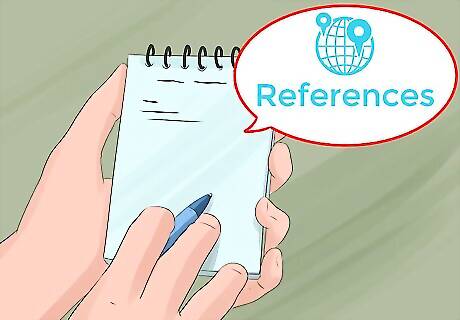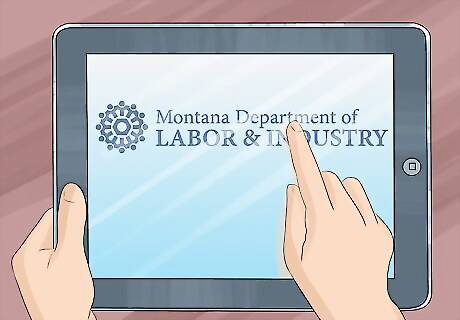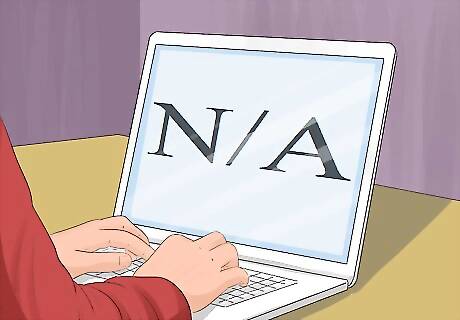
views
Preparing for the Application Process

Gather essential information such as your driver’s license and other forms to document your identity. In the United States, you need a Social Security number or other proof of the right to work.

Write out a detailed employment history. Always list most recent employment first, and move back in chronological order. For each job you've held, include: Company name and the city the company is located in Your job title, responsibilities, and accomplishments Dates you started and ended employment at the company

Prepare alternate answers if you have not had continuous employment. If you have no work history, have not worked for some time, or have been in prison, you still need to write something down in the "previous employment" section. The correct response can mean the difference between getting the job and being turned down. Gaps in Employment – If there are months or years between your jobs, you need to explain why. Note if you have been attending school or training. If you have been searching for a job for some time, you can simply write “job hunting.” No Work History – Even if you have not had a paying job, it is still best to include something in the employment section. List any volunteer, charitable, or casual labor jobs such as babysitting, doing lawn work, painting a house, or helping out on your family’s ranch. Prison – Write down the jobs you did in prison. As your employer, list the state where you were imprisoned if a state prison or the United States government if a federal prison.

Record information regarding your education. Some applications will request your entire education history from high school on, while other will only want to know the highest level of educations you attained. List most recent education first. Be sure to include: The name, location, and level (high school, GED, college, graduate) of each school attended The dates attended Any honors received If you are in school or working towards your GED, list the date you expect to receive your diploma.

Prepare answers for questions about felonies and being dismissed. Most applications will want to know if you've been convicted of a felony, or if you've ever been fired, forced to resigned, or resigned in order to avoid being fired. In responding, you can: List the incidents. Avoid words like “fired” or “quit” and used “involuntary separation” or “resigned”, respectively. Write “will discuss at interview.” This allows you to explain why you were fired or the extenuating circumstances behind a felony conviction. Remember that you do not have to report misdemeanors on applications. Also, if you have been charged with a felony but have not yet been found guilty, you may answer “no” when asked if you have been convicted.

Prepare a list of references with each person's name, their job title or relation to you, and their contact information. Most applications will want three references, and some companies will only want professional references. Keep a list that is a mix of professional and personal references so you can easily pick and choose who to list on each application. Nowadays, most prospective employers will ask for references instead of requiring them on the resume itself. You can include a section at the end of your resume that says "References available upon request." in this case. Professional references should be individuals such as employers or co-workers who have observed your work and can speak about your abilities. Personal references can be co-workers or friends, but should not be family members. Be sure to contact any references you list in advance to be sure they are willing to act as a reference.

Include special skills and credentials. Most applications have an “Other Related Experiences” section. You will want to tailor this information to the particular job you are applying for, but to prepare, make a list of the sorts of information you might include: Languages you speak, read, or write Machinery or equipment you can operate or repair Computer programs you know and any programming skills Licenses and certifications

Know what information not to provide. There are laws against discriminating against job candidates due to race, color, religion, sex, national origin, age, disability, or genetic information. The only information requested should be that which is essential for determining if the candidate is qualified. If a prospective employer asks for any of the following information, you should politely decline to provide it: Inquiries about disabilities Membership in organizations, clubs, societies, or lodges that may indicate an applicants race, sex, age, religion, or national origin Church membership Race, sex, or national origin information, if requested for tracking purposes, should be on a separate form that is not considered during the application review.

Create a model application. Plugging all your information into a single-page model application that is easy to carry with you will make it much easier when you have to fill out applications in person. If you have a smart phone, consider keeping this document on your phone so that it is always with you. You can find generic applications to use as the base for your model at many government websites such as labor.idaho.gov.

Have someone review your application. There are federal and state job centers in all 50 states that will review your application for free, as well as helping you search for jobs and preparing you for interviews. You can find a list of resources at http://www.dol.gov/dol/location.htm. At the very least, have a family member or friend whose opinion you trust look over your model application.
Filling Out the Application in Person

Bring your own black pens. Black is preferred to blue. Make sure you have pens that allow you to write neatly and legibly. A neat, clean application will be preferred to a messy one.

Dress in appropriate attire when asking for applications and when turning them in. You never get a second chance to make a first impression, as they say. Regardless of the job, managers are more likely to hire someone who looks professional. Also, you may end up getting an on-the-spot interview, so you want to look how you would when going in for a scheduled interview.

Ask if you can take a blank application home. It is always better, if possible, to take the application home so that you can take the time to fill it out neatly and have someone proofread your work.

Read the application fully, including any special instructions. Employers sometimes include specific instructions on applications to see if applicants can follow directions appropriately. For instance, you may be asked to list information in a certain order.

Use your model application as a template, but tailor your responses to the job. In describing jobs listed on your model application, emphasize the skills and experiences that are applicable to the job you are applying for. For example, if you have worked as a cook and are now applying to be a sales associate, you might emphasize your work ethic and ability to multitask when describing your cooking job. You may want to get two copies of the application and fill out a practice one first, so that you can produce a clean draft after having used the first to craft your responses.

Complete every space on the application. If something is not applicable to you, make sure that you mark it as “Not Applicable” or “N/A.” Otherwise, your potential employer may think that you accidentally skipped the question.

Proofread everything that you have written. You don't want a hiring manager to think of you as someone who makes errors that should be easily avoided. For checking bodies of text, reading backwards can catch spelling errors you'd miss by reading it normally. Make sure all information is accurate. You can be fired for presenting inaccurate information on your application.
Filling Out an Application Online

Do the application online if possible. There are several benefits to applying online: Since you will be typing, there are no worries about your handwriting. You can have other people review your application. You do not have to worry about staff getting the application to the hiring manager.

Read the application fully, including any special instructions. Employers sometimes include specific instructions on applications to see if applicants can follow directions appropriately. For instance, you may be asked to list information in a certain order.

Use your model application as a template, but tailor your responses to the job. When applying online, you can cut and paste text from your model application, but you will want to modify your generic responses to emphasize the skills and experiences that are applicable to the job you are applying for. For example, if you have worked as a cook and are now applying to be a sales associate, you might emphasize your work ethic and ability to multitask when describing your cooking job.

Complete every space on the application. If something is not applicable to you, make sure that you mark it as “Not Applicable” or “N/A.” Otherwise, your potential employer may think that you accidentally skipped the question.

Have someone proofread your application. Print out a copy of your application before you submit it and have a friend you trust or someone at a local job center look over it before you submit it.

Proofread one final time before submitting. You should also check your application yourself before submitting it. Make sure there are not spelling or grammatical errors and that all the information is correct. If you have cut and pasted text, make sure it shows up correctly when pasted, as specials formatting – i.e. italics, quotation marks, hyphens – are sometimes lost in the process.


















Comments
0 comment